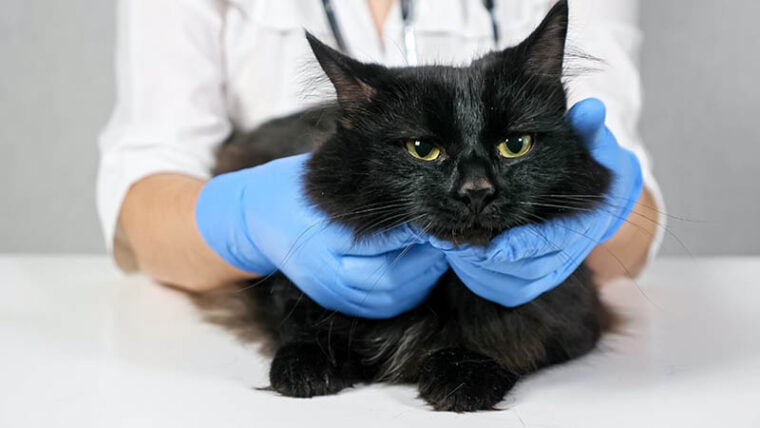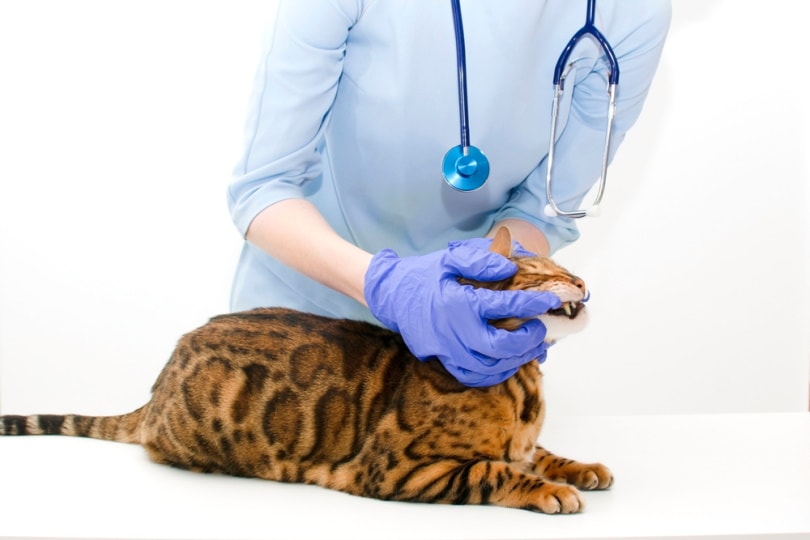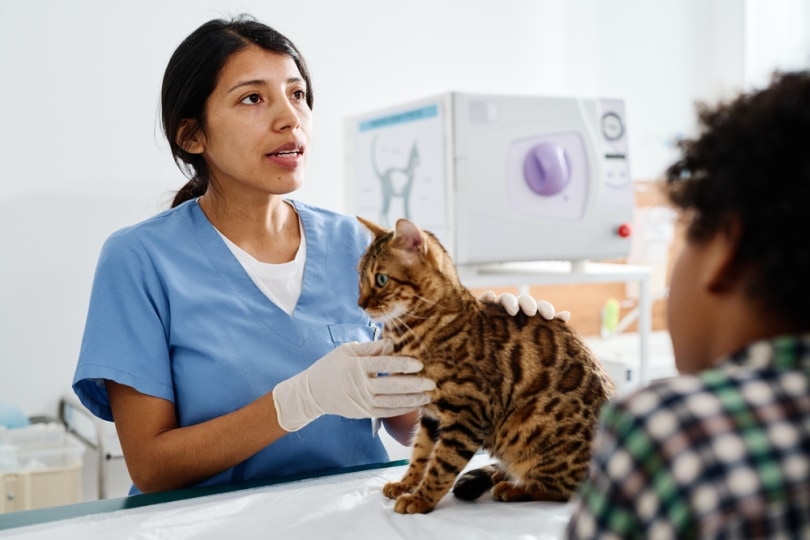
Click to Skip Ahead
Lymphadenopathy is another name for enlarged lymph nodes. Lymphadenopathy can occur for a number of reasons in cats, such as infection (bacterial and viral), IBD (inflammatory bowel disease), and cancer(s). In this article, we will discuss where lymph nodes can be found in cats, what their role is, the reasons why we can see them become enlarged, and what possible treatments may be.
What Are Lymph Nodes? And Where Are They Found?
The lymphatic system of a cat is a network of lymph nodes, connecting tracts, and various lymphatic organs found throughout the body. The lymph nodes themselves are soft, small grape-sized pieces of tissue along this system. One of the lymphatic system’s jobs is to drain the body of toxins, such as bacteria, viruses, and waste. The lymphatic tracts connect the lymph nodes and carry lymph, a fluid that contains, among other things, varying degrees of white blood cells, protein, and fat. White blood cells will be activated in times of inflammation, disease, and infection by the body’s immune system.
The lymphatic system and lymph nodes are found throughout the entire body. Some nodes will be palpable, or able to be felt, by a trained veterinarian. These lymph nodes can be found along the jawline, in front of and under the shoulders, behind the knee, and within the groin area.
There are also lymph nodes internally that one cannot feel within the chest and abdominal cavities. The chest nodes can never be felt due to the presence of the ribs and sternum. Lymph nodes within the abdomen can only be felt if they are significantly enlarged, and even then, this can be difficult. Oftentimes, unless the cat has lost significant weight, enlarged abdominal nodes cannot be felt.
Owners can sometimes feel or see the enlarged external lymph nodes on their cat, but be unaware what they are. Most owners and often veterinarians are unaware of enlarged internal lymph nodes without advanced testing, such as an ultrasound or CT scan.

The 4 Common Causes of Lymphadenopathy
1. Cancer
Causes
The most common cancer that can cause lymphadenopathy in cats is lymphoma. This type of cancer involves and invades the lymph nodes, causing enlargement. Oftentimes, owners and/or veterinarians will visibly see or feel the enlarged lymph nodes in the areas mentioned above. Frequently in cats, the abdominal lymph nodes, especially along the gastrointestinal tract, will also become enlarged.
GI tract lymphoma is the most common feline intestinal tumor, representing 74% of all feline intestinal tumors. Advanced testing, such as an ultrasound or CT scan is often needed to see the enlarged nodes. If your veterinarian is able to palpate them, they may often mistake them for a mass, which is why the diagnostics are needed to determine what is enlarged.
While lymphoma is the most common cancer to cause lymphadenopathy, other cancers can cause lymph nodes to become enlarged as well. Any tumor or mass in the body can metastasize or spread to adjacent lymph nodes. The lymph nodes will then become enlarged from the spread of the cancer. Other times, the cancer doesn’t metastasize to the nodes, but they become inflamed or reactive to the nearby cancer.
Signs
Your cat acting abnormal due to cancer will greatly depend on the type of cancer. With lymphoma, oftentimes, an affected cat will act normal despite having lymphadenopathy. Other times, vague abnormalities, such as lethargy, anorexia, vomiting, diarrhea, and abnormal drinking behavior will occur.
You may or may not notice lymphadenopathy in your cat. Your veterinarian may feel the enlarged lymph nodes and/or palpate the abdomen and be suspicious of what’s referred to as a “mass effect” in the abdomen. As discussed above, an ultrasound or CT scan of the chest and abdomen may be needed to determine that the lymph nodes are enlarged.
Care
This will also depend on the type of cancer. Some cancers, such as lymphoma, have great chemotherapy protocols available. Some of these chemo agents have to be given by a board-certified veterinary oncologist, while with others, your regular veterinarian may be able to administer them. There are even some oral chemotherapy agents available for your cat, depending on the type of cancer.
Lymphoma is not a surgical cancer—it is treated with chemotherapy or steroids. Other types of cancer may require surgery to remove the primary tumor. This will be determined by your veterinarian after testing has been completed to diagnose the type of cancer your cat has.
Depending on the cancer, since some cats become sick so quickly, or the cancer is rapidly progressive, pursuing aggressive therapy may not be an option. With these cats, palliative or hospice care may be an option. Your veterinarian will keep your cat comfortable with pain medications, steroids, anti-nausea medication, and appetite stimulants.

2. Bacterial Infection(s)
Causes
Dental disease is a common occurrence in cats. Some cats will just get simple gingivitis (inflammation of the gum tissue) and tartar. Other cats will get such advanced dental disease that they can get tooth root abscesses and brittle jaw bone(s) due to the condition. Bacterial infection goes along with dental disease. Again depending on the severity, you may only notice a bad breath to your cat. Other times the adjacent lymph nodes along the jawline and/or in front of the shoulder blades will start to try and clear the infection, becoming enlarged as they do so.
Other types of bacterial infections causing lymphadenopathy are any type of abscess. An abscess is a pocket of infection, or purulent material, often secondary to a bite or penetrating trauma. The abscess will form at the site or within the tissue near the site of trauma. The nearby lymph nodes will then become inflamed due to reactivity.
Signs
If your cat has dental disease or an abscess, you may notice an odor and/or discharge from the infected area. Lymph nodes in that region may be enlarged and sometimes painful to touch. Your cat may not want to eat, be dropping food, pawing at their mouth, lethargic or otherwise not him/herself.
Care
Any type of bacterial infection requires antibiotics to treat. Your veterinarian will choose an antibiotic depending on the cause of the infection, area of the body affected and if you are able to give your cat medications or not. Oftentimes your veterinarian will also prescribe pain medications and anti-inflammatories. If your cat has a severe dental infection, a cleaning with probably tooth extractions will also likely be recommended.
3. Viral Infection(s)
Causes
While the terms FIV, FeLV and FIP may sound familiar to you, you may not know what these diseases are. All of these abbreviations refer to a different common viral disease in cats. FIV (feline immunodeficiency virus), FeLV (feline leukemia virus) and FIP (feline infectious peritonitis) are all contagious viruses amongst felines. All of these viruses are most common in both outdoor-only cats and indoor/outdoor cats. However, we can also commonly see them in cats who were previously stray and are now kept inside, or even cats who may have escaped out of the house for a short period of time before coming back in.
While there are some differences amongst each virus, generally speaking, each one is spread amongst cats through the blood, bites, and infected bodily secretions, such as saliva and sometimes urine. FIP is caused by a virus that, by itself, is not harmful. However, if that specific virus mutates within a cat, that is when we see the disease FIP develop.
Signs
As mentioned, cats can be carriers of the virus that causes FIP and never become sick because the virus does not mutate. Cats may also just be carriers of FeLV and FIV but never develop what is referred to as clinical disease.
Clinical disease is when a cat shows signs of illness. This can manifest as lethargy, low red and white blood cell counts, seizures, tremors, organ failure, weight loss, and build-up of fluid within the chest and/or abdomen. With any of the viral diseases, lymphadenopathy internally within the abdomen is most common. However, because the viruses can affect the entire body, any of the lymph nodes can become enlarged and reactive.
Care
Care is aimed at being supportive and palliative only. There are no cures for FIP, FeLV or FIV. Once a cat is infected, they will have the virus for their entire life. If your cat becomes clinically ill, as with cancer, your veterinarian can discuss palliative and/or hospice care.
Prevention is the best option, with effective vaccines being available for FeLV and FIV. Unfortunately, your cat may have been exposed long before you adopted them. It is best to have them tested by your veterinarian prior to starting any vaccines, and discussing all options with your vet first.

4. IBD or Inflammatory Bowel Disease
Causes
IBD is a fairly common condition in cats. It’s not something anyone can diagnose solely on a physical exam. Advanced testing, such as an ultrasound or CT scan, is needed to visualize the thickened intestines and associated lymphadenopathy. Cytology or histopathology is then needed to officially diagnose IBD. Veterinarians and researchers are unsure of an exact cause to IBD, but many believe that it is an immune-mediated disease.
Signs
Lymph nodes near the intestinal tract are often enlarged in addition to thickening of the intestinal tract. Your veterinarian may or may not be able to feel this on exam. Your cat will often have diarrhea and/or vomiting, weight loss, and a decreased appetite. Other times, your cat may want to keep eating but is unable to keep any food down. IBD and intestinal lymphoma are often very difficult to distinguish from one another.
Care
The mainstay of treatment for cats with IBD is steroids. If you are able to get other medications into your cat, your veterinarian may also recommend additional immunosuppressant medications. Some cats are put on a prescription diet, appetite stimulants, and anti-vomiting medications as well. All treatment depends on how much your cat will tolerate and what is effective.
Treatments are often lifelong. While some medications can be weaned down, most cats will need to be on treatment indefinitely, or they will end up becoming sick again.
Frequently Asked Questions
Will the lymph nodes go back to a normal size?
Most of the time, no matter the reason, the lymph nodes will go back to normal size if the underlying problem is appropriately treated. Even with some cancers, the lymph nodes can go back to a normal size, and a cat can go into remission if appropriately treated. If the cause of the swollen lymph nodes is not addressed, the lymph nodes will continue to be enlarged.
How long can a cat live with lymphadenopathy?
This completely depends on the cause. A simple infection and/or abscess typically won’t affect a cat’s lifespan. However, a clinically ill cat with FIP, FeLV, FIV or some cancers may have a significantly shortened lifespan due to the disease. Once your cat is diagnosed, you should speak with your veterinarian about any changes in life expectancy.

What will treatment for my cat’s lymphadenopathy cost?
Unfortunately, this can also vary greatly depending on the cause. If there is an infection, a simple course of antibiotics may only cost $40–$50. However, life-long therapy for IBD and/or cancer may cost into the thousands. Your veterinarian should go over all costs of treatment—both acute and long term—once your cat has a diagnosis for their lymphadenopathy.
Conclusion
Lymph node inflammation, or lymphadenopathy, can be seen for a number of different reasons in cats. This can include cancer, bacterial infection, viral infection, or intestinal inflammation. Depending on the cause, some of these conditions can be treated and even cured. Other diseases will be lifelong, and your cat can receive palliative or hospice care only. Whatever the cause, enlarged lymph nodes require testing to determine a cause and treatment. Should you notice any swellings on your cat, or if they are unwell in general, veterinary care should also be pursued.
Featured Image Credit: Lenar Nigmatullin, Shutterstock







